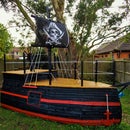Introduction: Low-Poly Paper Sculptures
In this instructable you will learn everything from editing 3d computer models into flat nets, to creating your own finished paper sculpture.
I love using paper for drawing, making pop up cards, models, paper aeroplanes and origami… so why not use it for making beautiful 3d scale models of anything you desire! Paper models can be quite time consuming depending on their complexity, and making one requires lots of patience and fiddley-ness. I have had lots of fun making paper models and they create stunning pieces to display around your home, so let’s jump right in.
You will need
A pair of scissors – The sharper the better, I prefer using a longer pair with a big handle, they’re easier to control.
A printer – Nothing fancy just something that prints things onto paper.
Paper! – This will differ on your model size and complexity. For bigger and simpler models, go for thicker card (between 200-300gsm). For complex and smaller models, use standard card (120-200gsm). I would not recommend using thin paper as the model will be flimsy and weak.
Pepakura Designer – Unfortunately this program is not free to download but I would very much recommend you to buy it it’s great for everything papercraft.
Meshlab – This is free software used for converting the model into low polygonal shapes which we can use.
Glue – I used PVA glue in a little dispenser bottle but you can use any other craft glue on the market. Do not use superglue, it doesn’t need to be that strong and it’s expensive.
Acrylic Spray Paint – You will need these if you intend to colour your model (if you do not already have coloured card). Water based paints could deform and weaken the final structure of the model so stay away from these.
Click here to download Pepakura Designerand click here to download Meshlab, you will need to install these before we begin.
Step 1: Choosing and Editing Your Model
When choosing a model you intend to make, try to keep it
simple. Objects with thin long sections are very hard to recreate using nets (e.g. whiskers or very thin tails). Rounder, more curved models work best and retain their shape the most. The example I will be making along the way will be an African elephant, it has a perfect mixture of large rounded edges with a few complex areas like the trunk, tail and tusks.
To find the base model you would like to begin with, look for it on Thingiverse, this is a site which contains thousands of free downloadable models used mostly for 3D printing. When you find your model you need to download it as a “.stl” file.
Editing
Instructable member ‘krummrey’ has made a brilliant
instructable for this stage of the build; check out their instructable here for a more detailed explanation if you need, but I will go through the basics here...
Open Meshlab and import your chosen model by going to file>Import Mesh> and opening the .stl file. The new file should appear in the centre of the screen.Now go to the filters menu, to ‘Remeshing, Simplification and Construction’ and select ‘Quadric edge collapse decimation’. A new window will open displaying your face count and other options. Your face count is the current amount of flat surfaces that make up your model and the quantity usually relates to quality of model. We now want to turn the face count to anywhere between 200-500 faces, select ‘preserve topology’ and click apply. Unfortunately Meshlab has no ‘undo’ button so you may need to import the mesh again if you overshoot with the amount of faces you choose. Your aim is to have a comfortable number of faces whilst still keeping the rough shape of the model. Here you will choose how detailed your model will become (over 500 faces will be a nightmare to cut out of paper so don’t make your model too detailed).
Your model should now have a low polygonal style and will look the way it will when it is finished. You can now export the file into ‘.obj’ format; this is a format which can be opened in Pepakura designer.
Step 2: Using Pepakura Designer to Make Nets
Now that your file is in obj form, you can open it into
Pepakura Designer. When opened it will ask you to orientate your model correctly using the colours and arrows, it may also tell you you have too many faces, but… we’ll forget about that for now. You should have the model showing on the left of the screen with a white space on the right, you can use the right mouse button to pan around the model to see it from all angles.
To ‘unfold’ the model simply click the unfold button on the tool bar. This may take some time as it is quite complicated. Now on your screen a large mess of shapes should appear in the previously blank area of the program, this is the 2D version of your net. You will now need to scale your model, go to >2D menu>Change Scale>Set Scale and by changing the numbers in the boxes set the sizes to the dimensions you wish to achieve. It will become very difficult to re-scale your model after editing the shapes so try to pick a good size now.
Go to 2D menu and select ‘Show Flaps’ and ‘Show Edge ID’; this will create tabs on the pieces so that we can glue them together when assembling the model. By right clicking in an empty space you can select the ‘Join/Disjoin Face’ tool. Using this tool you need to break apart the large net you currently have into smaller nets which fit onto the pieces of paper, indicated by the dashed lines. The aim is to fit as many pieces onto one page but keep them as simple as possible. Try to aim for an average of 7 polygons per piece.
Once you have arranged all your pieces onto the pages, tick ‘Show Page Number’ in the 2D menu tab. You can now send your pages to the printer and print your pieces onto your selected card. Once printed, it helps to lay all the pages out in order so finding which pieces to add becomes easier in the next step.
Step 3: Cutting and Assembling Your Model
When selecting where to start on your model, there are
always better places than others; if your model has legs or ears its best to start from them. You need to start with these confined areas as they will be impossible to complete later due to their long thin shape. For example I started with the trunk of my elephant, and separately made, then added the legs, ears and tail to the main body as I went along. If I were to finish with the trunk there would be nowhere for me to get my hands in to apply pressure to the gluing tabs.
So, now that you have selected where you want to begin, its always handy to keep pepakura designer open so you can easily find the piece you're looking for. Click on the desired piece on the model in pepakura designer, it should then highlight red and highlight which page it is on. When you have found the printed piece you are looking for, cut it out with the scissors. Only cut the solid black lines, the dotted lines are for folding.
When your individual piece is cut, fold along the dotted and dashed lines. Usually, the dotted lines are mountain folds and the dot-dashed lines are valley folds, however as you do not want to see the lines on the outside of your model you need to fold in the opposite direction, this will result in the model being flipped. So to make sure on this occasion to fold the lines in the opposite direction, fold as follows…
(-----------------------)=Valley fold- Fold the card closed
(-~-~-~-~-~-~-~-~-~-)=Mountain fold- Fold the card back
Once you have two adjacent pieces cut and folded they can be glued. Do not put too much glue on the tabs because it will squeeze out. Apply a thin even layer to the full length of the tab and align it to the edge on the other piece with the corresponding tab number. Press the pieces firmly together until they are stuck, they should only take about 7 seconds per tab to stick enough for you to let go. It is important to keep the tabs aligned so that the next tab will not be out of place. Continue selecting pieces and gluing them to build up your model. As I said previously, it might be worth making detailed/difficult sections separately, and gluing them together afterwards.
When you are nearing the end of the gluing, try to aim for a part of the model that will not be seen as your last tab to glue, it’s theoretically impossible to get a perfect glue on your last tab so make sure it’s not too obvious.
Congratulations! You have made your own low polygonal 3D paper model! If you feel like spraying the model take it outside or in a well ventilated environment and spray it using acrylic paint, it’s always best to have many thin coats than few thick coats of paint on your model.
I have included the Pepakura and PDF files of this elephant if you would like to have a go yourself.
Thank you for reading this instructable, I had loads of fun making my low poly paper elephant and I hope you’ve learned something. I also made a rabbit using the same technique and it turned out great!
I would love it if you could leave a favourite and vote for me in the competition!
Happy Making!
Thank You
Marco
:)
Attachments

Second Prize in the
Papercraft Contest 2017















